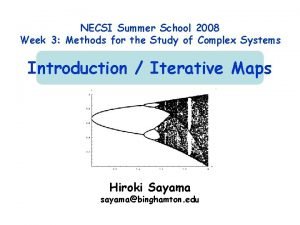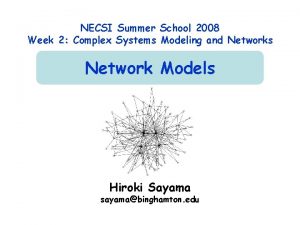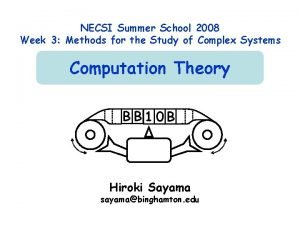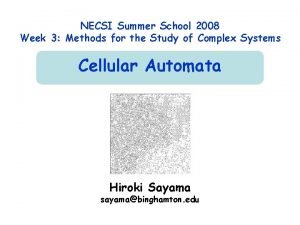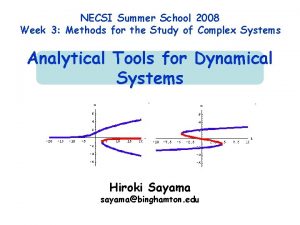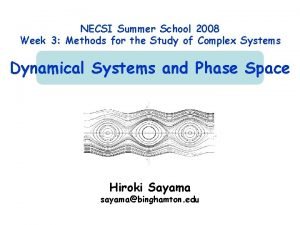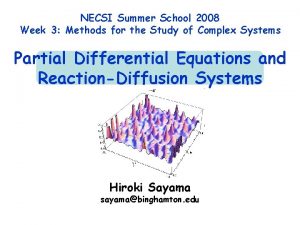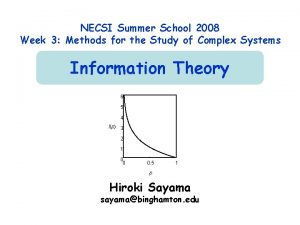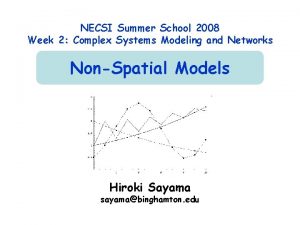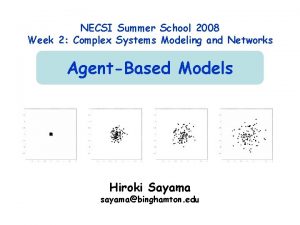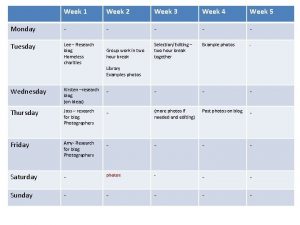NECSI Summer School 2008 Week 3 Methods for







































- Slides: 39

NECSI Summer School 2008 Week 3: Methods for the Study of Complex Systems Stochastic Systems Hiroki Sayama sayama@binghamton. edu

Four approaches to complexity Nonlinear Dynamics Complexity = No closed-form solution, Chaos Computation Complexity = Computational time/space, Algorithmic complexity Information Complexity = Length of description, Entropy Collective Behavior Complexity = Multi-scale patterns, Emergence 2

Stochastic system • Deterministic system xt = F(xt-1, t) • Stochastic system (w/ discrete states) Px(s; t) = Ss’ Px(s|s’) Px(s’; t-1) Px(s; t): Probability for x to be s at time t Px(s|s’): Transition probability for x in state s’ to change to s in one time step • Assumed time-independent 3

Exercise • Write the model of the following system in mathematical form – Numbers on arrows are transition probabilities 1/4 3/4 0 1 1/4 3/4 4

Random Walk 5

Random walk • Time series in which random noise is added to the system’s previous state xt = xt-1 + d – d : random variable (e. g. , +1 or -1) – Many stochastic events that accumulate and form the system’s history 6

Exercise • Derive a mathematical representation of random walk using probability distribution, assuming: – Possible states: integers (unbounded) – Probability of moving upward and downward: 50%-50% Px(s|s’) = ½ d(s, s’+1) + ½ d(s, s’-1) d(a, b): Kronecker’s delta function 7

Where will you be after t steps? • Exact position of individual random walk is hard to predict, but you can still statistically describe where it is likely to go 8

Exercise • Show analytically that the expected position of a particle in random walk will not change over time <s> = Ss s Px(s; t) 9

Exercise • Show analytically that the root square means (RMS) distance a particle travels in random walk will grow over time with power=1/2 √<(s-s 0)2> = { Ss (s-s 0)2 Px(s; t) }1/2 10

Dependence on time scale • Distribution of positions flattens over time (diffusion of probability) 11

After sufficiently long time • Positions of many random-walking particles follow a “normal distribution” – A. k. a. Gaussian distribution, bell curve 2 2 -(x-m) /(2 s )/(2 ps 2)1/2 e s m ~ m: mean s: standard deviation 12

Relation to the central limit theorem • Sum (and hence average) of many independent random events will approximately follow a normal distribution (regardless of probability distribution of those random events) – Each step of random walk corresponds to an independent event – Position of a particle corresponds to the sum of those events 13

Self-Similar Properties of Individual Random Walk 14

Structure of a single random walk Random walk produces self-similar trajectory 15

Fractal time series • Random walk is a very simple example of “fractal” time series – Time series whose portion has statistical properties similar to those of the whole series itself – Shows stochastic self-similarity – The word “fractal” came from the fact that these structures have fractional (non-integral) dimensions 16

Power law (scaling law) • Random walk’s power spectrum shows an inverse power law distribution • For such systems, averaging system states over time fails P P(w) ~ w-k w Power of large fluctuation Power of small fluctuation The more data you collect, the larger fluctuation you find (scaling) 17

Exercise: Failure of averaging • Produce time series data using a random walk model • Average the system state for the first t steps • Plot this average as a function of t • Does the average become more accurate as you increase t? 18

Dynamics of fractal time series • They are always fluctuating, but not completely random • There are gentle correlations between past, present, and future (regularity) • The similar dynamics appear over a wide range of time scales, without any characteristic frequency 19

Fractal time series in society • Many other real-world time series generated by complex social/ economical systems (i. e. , many interacting parts) have fractal characteristics – Stock prices – Currency exchange rates 20

Fractal time series in biology • Many biological/physiological time series data are found to be fractal – Heartbeat rates, breathing intervals, human gaits, body temperature, etc. • They are usually fractal if a subject is normal and healthy • If they look very regular, the subject is probably not healthy • For details see, e. g. , http: //www. physionet. org/tutorials/fmnc/ 21

Transition Probability Matrix and Asymptotic Probability Distribution 22

Time evolution of probabilities • If we consider probability distribution Px(si; t) as a meta-state of the system, its time evolution is linear Px(si; t) = Sj Px(si|sj) Px(sj; t-1) pt = A pt-1 – pt: Probability vector – A: Transition probability matrix • If original state space is finite and discrete 23

Convenient properties of transition probability matrix • The product of two TPMs is also a TPM • All TPMs have eigenvalue 1 • |l| 1 for all eigenvalues of any TPM • If the transition network is strongly connected, the TPM has one and only one eigenvalue 1 (no degeneration) 24

Exercise: Prove the following • The product of two TPMs is also a TPM • All TPMs have eigenvalue 1 • |l| 1 for all eigenvalues of any TPM • If the transition network is strongly connected, the TPM has one and only one eigenvalue 1 (no degeneration) 25

Answer (1) • All TPMs have eigenvalue 1 – You can show that there exists a nonzero vector q that satisfies A q = q, i. e. (A-I) q = 0 → |A-I| = 0 This holds when column vectors of A-I are linearly dependent with each other (i. e. , A-I maps vectors to a subspace of fewer dimensions) 26

Answer (1) • A-I actually looks like this: a 11 -1 a 12 … a 1 n a 21 a 22 -1 … a 2 n : an 1 : an 2 … : ann-1 … • Note that each column vector is in a subspace s 1+s 2+. . . +sn = 0 → |A-I| = 0 27

Answer (2) • |l| 1 for all eigenvalues of any TPM – For any l, Amq = lmq (q: eigenvector) – Am is a product of TPM, therefore it must be a TPM as well whose elements are all <= 1 – Amq = lmq can’t diverge → |l | 1 28

TPM and asymptotic probability distribution • |l| 1 for all eigenvalues of any TPM • If the transition network is strongly connected, the TPM has one and only one eigenvalue 1 (no degeneration) → This eigenvalue is a unique dominant eigenvalue and the probability vector will eventually converge to its corresponding eigenvector 29

An Application: Google’s “Page. Rank” 30

’s “Page. Rank” Page. Rank Explained (from http: //www. google. com/technology/) “Page. Rank relies on the uniquely democratic nature of the web by using its vast link structure as an indicator of an individual page's value. In essence, Google interprets a link from page A to page B as a vote, by page A, for page B. But, Google looks at more than the sheer volume of votes, or links a page receives; it also analyzes the page that casts the vote. Votes cast by pages that are themselves "important" weigh more heavily and help to make other 31 pages “important. ” ”

Page. Rank explained mathematically • Lawrence Page, Sergey Brin, Rajeev Motwani, Terry Winograd, 'The Page. Rank Citation Ranking: Bringing Order to the Web' (1998): http: //www-db. stanford. edu/~backrub/pageranksub. ps • Node: Web pages • link: WWW hyperlinks • State: Temporary “importance” of that node • Its coefficient matrix is a transition probability matrix that can be obtained by dividing each column of the adjacency matrix by the number of 1’s in that column. 32

Example s 1 s 2 s 5 s 3 s 4 0 0. 5 0 0 0. 5 1 0. 5 0 0 0 0. 5 1 0 0 (In the actual implementation of Page. Rank, positive non-zero weights are forcedly assigned to all pairs of nodes in order to make the entire network strongly connected) 33

Interpreting the Page. Rank network as a stochastic system (1) s 1 s 2 s 5 s 3 s 4 • State of each node can be viewed as a relative population that are visiting the webpage at t • At next timestep, the population will distribute to other webpages linked from that page evenly 34

Interpreting the Page. Rank network as a stochastic system (2) s 1 s 2 s 5 s 3 s 4 • Importance of each webpage can be measured by calculating the final equilibrium state of such population distribution 35

Therefore. . . • Just one dominant eigenvector of the TPM of a strongly connected network always exists, with l = 1 • This shows the equilibrium distribution of the population over WWW • So, just solve x = Ax and you will get the Page. Rank for all the web pages on the World Wide Web!! 36

Exercise s 1 s 2 s 5 s 3 s 4 0 0. 5 0 0 0. 5 1 0. 5 0 0 0 0. 5 1 0 0 Calculate the Page. Rank of each node in the above network (the network is already strongly connected so you can directly calculate its dominant eigenvector) 37

Summary • Stochastic systems may be modeled using probability distributions • Random walk shows ~t 1/2 RMS growth and fractal time series patterns • Time evolution of probability distributions may be modeled analyzed as a linear system – Asymptotic distribution can be uniquely obtained if the transition network is strongly connected 38

FYI: Master equation • A continuous-time analog of the same stochastic processes d. P(s)/dt = Ss’≠s ( R(s|s’) P(s’) – R(s’|s) P (s) ) – R(a|b): Rate of transition from b to a 39
 Necsi
Necsi Necsi
Necsi Necsi
Necsi 2008 2008
2008 2008 Week by week plans for documenting children's development
Week by week plans for documenting children's development Summer school lodi unified
Summer school lodi unified Crescenta valley high school summer school
Crescenta valley high school summer school Haltom high school summer school
Haltom high school summer school Metal coping fpd
Metal coping fpd 2008-2009 school year
2008-2009 school year 2008 fashion middle school
2008 fashion middle school Fspos vägledning för kontinuitetshantering
Fspos vägledning för kontinuitetshantering Typiska novell drag
Typiska novell drag Nationell inriktning för artificiell intelligens
Nationell inriktning för artificiell intelligens Returpilarna
Returpilarna Varför kallas perioden 1918-1939 för mellankrigstiden
Varför kallas perioden 1918-1939 för mellankrigstiden En lathund för arbete med kontinuitetshantering
En lathund för arbete med kontinuitetshantering Särskild löneskatt för pensionskostnader
Särskild löneskatt för pensionskostnader Tidbok för yrkesförare
Tidbok för yrkesförare Anatomi organ reproduksi
Anatomi organ reproduksi Vad är densitet
Vad är densitet Datorkunskap för nybörjare
Datorkunskap för nybörjare Boverket ka
Boverket ka Debattartikel struktur
Debattartikel struktur Autokratiskt ledarskap
Autokratiskt ledarskap Nyckelkompetenser för livslångt lärande
Nyckelkompetenser för livslångt lärande Påbyggnader för flakfordon
Påbyggnader för flakfordon Arkimedes princip formel
Arkimedes princip formel Svenskt ramverk för digital samverkan
Svenskt ramverk för digital samverkan Jag har nigit för nymånens skära text
Jag har nigit för nymånens skära text Presentera för publik crossboss
Presentera för publik crossboss Argument för teckenspråk som minoritetsspråk
Argument för teckenspråk som minoritetsspråk Plats för toran ark
Plats för toran ark Treserva lathund
Treserva lathund Fimbrietratt
Fimbrietratt Claes martinsson
Claes martinsson Centrum för kunskap och säkerhet
Centrum för kunskap och säkerhet Byggprocessen steg för steg
Byggprocessen steg för steg Mat för unga idrottare
Mat för unga idrottare Verktyg för automatisering av utbetalningar
Verktyg för automatisering av utbetalningar
